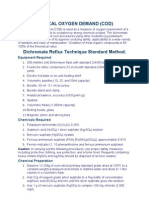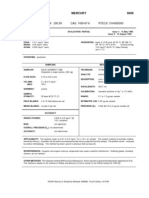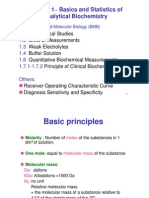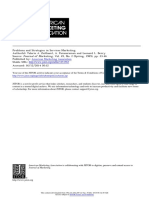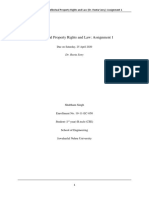METHOD #: 245.2 Title: Analyte: Instrumentation: Storet No
METHOD #: 245.2 Title: Analyte: Instrumentation: Storet No
Uploaded by
Chuquiure L. AngelCopyright:
Available Formats
METHOD #: 245.2 Title: Analyte: Instrumentation: Storet No
METHOD #: 245.2 Title: Analyte: Instrumentation: Storet No
Uploaded by
Chuquiure L. AngelOriginal Title
Copyright
Available Formats
Share this document
Did you find this document useful?
Is this content inappropriate?
Copyright:
Available Formats
METHOD #: 245.2 Title: Analyte: Instrumentation: Storet No
METHOD #: 245.2 Title: Analyte: Instrumentation: Storet No
Uploaded by
Chuquiure L. AngelCopyright:
Available Formats
METHOD #: 245.2 TITLE: ANALYTE: INSTRUMENTATION: STORET No.
Approved for NPDES and SDWA (Issued 1974) Mercury (Automated Cold Vapor Technique) CAS # Hg Mercury 7439-97-6 AA Total 71900 Dissolved 71890 Suspended 71895
1.0
Scope and Application 1.1 This method is applicable to surface waters. It may be applicable to saline waters, wastewaters, effluents, and domestic sewages providing potential interferences are not present (See Interference 4). The working range is 0.2 to 20.0 Fg Hg/L.
1.2 2.0
Summary of Method 2.1 The flameless AA procedure is a physical method based on the absorption of radiation at 253.7 nm by mercury vapor. The mercury is reduced to the elemental state and aerated from solution. The mercury vapor passes through a cell positioned in the light path of an atomic absorption spectrophotometer. Absorbance (peak height) is measured as a function of mercury concentration and recorded in the usual manner. In addition to inorganic forms of mercury, organic mercurials may also be present. These organo-mercury compounds will not respond to the flameless atomic absorption technique unless they are first broken down and converted to mercuric ions. Potassium permanganate oxidizes many of these compounds but recent studies have shown that a number of organic mercurials, including phenyl mercuric acetate and methyl mercuric chloride, are only partially oxidized by this reagent. Potassium persulfate has been found to give approximately 100% recovery when used as the oxidant with these compounds. Therefore, an automated persulfate oxidation step following the automated addition of the permanganate has been included to insure that organo-mercury compounds, if present, will be oxidized to the mercuric ion before measurement.
2.2
3.0
Sample Handling and Preservation 3.1 Until more conclusive data are obtained, samples should be preserved by acidification with nitric acid to a pH of 2 or lower immediately at the time of collection.") If only dissolved mercury is to be determined, the sample should be filtered before the acid is added. For total mercury the filtration is omitted.
4.0
Interference (See NOTE 1)
4.1 4.2
4.3
4.4
Some sea waters and waste-waters high in chlorides have shown a positive interference, probably due to the formation of free chlorine. Interference from certain volatile organic materials which will absorb at this wavelength is also possible. A preliminary run under oxidizing conditions, without stannous sulfate, would determine if this type of interference is present. Formation of a heavy precipitate, in some wastewaters and effluents, has been reported upon addition of concentrated sulfuric acid. If this is encountered, the problem sample cannot be analyzed by this method. Samples containing solids must be blended and then mixed while being sampled if total mercury values are to be reported. NOTE 1: All the above interferences can be overcome by use of theManual Mercury method in this manual.
5.0
Apparatus 5.1 Technicon Auto Analyzer consisting of: 5.1.1 Sampler II with provision for sample mixing. 5.1.2 Manifold. 5.1.3 Proportioning Pump II or III. 5.1.4 High temperature heating bath with two distillation coils (Technicon Part # 116-0163) in series. Vapor-liquid separator (Figure 1). Absorption cell, 100 mm long, 10 mm diameter with quartz windows. Atomic Absorption Spectrophotometer (See Note 2): Any atomic absorption unit having an open sample presentation area in which to mount the absorption cell is suitable. Instrument settings recommended by the particular manufacturer should be followed. NOTE 2: Instruments designed specifically for the measurement of mercury using the cold vapor technique are commercially available and may be substituted for the atomic absorption spectrophotometer. Mercury Hollow Cathode Lamp: Westinghouse WL-22847, argon filled, or equivalent. Recorder: Any multi-range variable speed recorder that is compatible with the UV detection system is suitable. Source of cooling water for jacketed mixing coil and connector A-7. Heat lamp: A small reading lamp with 60W bulb may be used to prevent condensation of moisture inside the cell. The lamp is positioned to shine on the absorption cell maintaining the air temperature in the cell about 10C above ambient.
5.2 5.3 5.4
5.5 5.6 5.7 5.8
6.0
Reagents 6.1 Sulfuric Acid, Conc: Reagent grade 6.1.1 Sulfuric acid, 2 N: Dilute 56 mL of conc. sulfuric acid to 1 liter with distilled water. 6.1.2 Sulfuric acid, 10%: Dilute 100 mL conc. sulfuric acid to 1 liter with distilled water.
6.2
6.3
6.4
6.5 6.6 6.7 6.8
6.9
Nitric acid, Conc: Reagent grade of low mercury content. 6.2.1 Nitric Acid, 0.5% Wash Solution: Dilute 5 mL of conc. nitric acid to 1 liter with distilled water. Stannous Sulfate: Add 50 g stannous sulfate to 500 mL of 2 N sulfuric acid (6.1.1). This mixture is a suspension and should be stirred continuously during use. NOTE 3: Stannous chloride may be used in place of stannous sulfate. Sodium Chloride-Hydroxylamine Sulfate Solution: Dissolve 30 g of sodium chloride and 30 g of hydroxylamine sulfate in distilled water to 1 liter. NOTE 4: Hydroxylamine hydrochloride may be used in place of hydroxylamine sulfate. Potassium Permanganate: 0.5% solution, w/v. Dissolve 5 g of potassium permanganate in 1 liter of distilled water. Potassium Permanganate, 0.1 N: Dissolve 3.16 g of potassium permanganate in distilled water and dilute to 1 liter. Potassium Persulfate: 0.5% solution, w/v. Dissolve 5 g potassium persulfate in 1 liter of distilled water. Stock Mercury Solution: Dissolve 0.1354 g of mercuric chloride in 75 mL of distilled water. Add 10 mL of conc. nitric acid and adjust the volume to 100.0 mL. 1.0 mL = 1.0 mg Hg. Working Mercury Solution: Make successive dilutions of the stock mercury solution (6.8) to obtain a working standard containing 0.1 Fg per mL. This working standard and the dilutions of the stock mercury solution should be prepared fresh daily. Acidity of the working standard should be maintained at 0.15% nitric acid. This acid should be added to the flask as needed before the addition of the aliquot. From this solution prepare standards containing O.2, 0.5, 1.0, 2.0, 5.0,10.0, 15.0 and 20.0 Fg Hg/L. 6.10 Air Scrubber Solution: Mix equal volumes of 0.1 N potassium permanganate (6.6) and 10% sulfuric acid (6.1.2).
7.0
Procedure 7.1 7.2 7.3 Set up manifold as shown in Figure 2. Feeding all the reagents through the system with acid wash solution (6.2.1) through the sample line, adjust heating bath to 105C. Turn on atomic absorption spectrophotometer, adjust instrument settings as recommended by the manufacturer, align absorption cell in light path for maximum transmittance and place heat lamp directly over absorption cell. Arrange working mercury standards from 0.2 to 20.0 Fg Hg/L in sampler and start sampling. Complete loading of sample tray with unknown samples. Prepare standard curve by plotting peak height of processed standards against concentration values. Determine concentration of samples by comparing sample peak height with standard curve. NOTE 5: Because of the toxic nature of mercury vapor, precaution must be taken to avoid its inhalation. Venting the mercury vapor into an exhaust hood or passing the vapor through some absorbing media such as: a) equal volumes of 0.1 N KMnO4 (6.6) and lO% H SO (6.1.2). 2 4 b) 0.25% iodine in a 3% KI solution, is recommended. A specially treated charcoal that will adsorb mercury vapor is also available from Barnebey and Cheney, E. 8th Ave. and North Cassidy St., Columbus,
7.4 7.5
7.6
Ohio 43219, Cat. #580-13 or #580-22. After the analysis is complete put all lines except the H2SO4 line in distilled water to wash out system. After flushing, wash out the H 2SO 4 line. Also flush the coils in the high temperature heating bath by pumping stannous sulfate (6.3) through the sample lines followed by distilled water. This will prevent build-up of oxides of manganese.
8.0
Precision and Accuracy 8.1 In a single laboratory (SEWL), using distilled water standards at concentrations of 0.5, 1.0, 2.0, 5.0, 10.0 and 20.0 Fg Hg/L, the standard deviations were 0.04, 0.07, 0.09, 0.20, 0.40 and 0.84 Fg/L, respectively. In a single laboratory (SEWL), using surface water samples spiked with ten organic mercurials at the 10 Fg/L level, recoveries ranged from 87 to 117%. Recoveries of the same ten organic mercurials in distilled water at the 10 Fg/L level, ranged from 92% to 125% Bibliography
8.2
1.
2. 3.
4.
5.
Wallace, R. A., Fulkerson, W., Shults, W. D., and Lyon, W. S., "Mercury in the Environment-The Human Element", Oak Ridge National Laboratory, ORNL-NSF-EP-I, p 31, (January, 1971). Hatch, W. R. and Ott, W. L., "Determination of Sub-Microgram Quantities of Mercury by Atomic Absorption Spectrophotometry", Anal. Chem. 40, 2085 (1968). Brandenberger, H. and Bader, H., "The Determination of Nanogram Levels of Mercury in Solution by a Flameless Atomic Absorption Technique", Atomic Absorption Newsletter 6, 101 (1967). Brandenberger, H. and Bader, H., "The Determination of Mercury by Flameless Atomic Absorption II, A Static Vapor Method", Atomic Absorption Newsletter 7, 53 (1968). Goulden, P. D. and Afghan, B. K., "An Automated Method for Determining Mercury in Water", Technicon, Adv. in Auto. Anal. 2, p 317 (1970).
You might also like
- Beverage Density Lab 1Document4 pagesBeverage Density Lab 1api-23821364650% (2)
- 4500-F Fluoride : 4-82 Inorganic Nonmetals (4000)Document8 pages4500-F Fluoride : 4-82 Inorganic Nonmetals (4000)ShadiaMilenaOquendoMuñozNo ratings yet
- SM 4500 FluorideDocument8 pagesSM 4500 FluorideAnonymous FRAdEnNo ratings yet
- Psychological AssessmentDocument3 pagesPsychological AssessmentCnfsr KayceNo ratings yet
- Bridgestone PresentationDocument21 pagesBridgestone PresentationTeju Gavankar100% (1)
- Aas HG Epa Method 2452Document6 pagesAas HG Epa Method 2452Ahmed GwealyNo ratings yet
- EPA 245.5 HGDocument4 pagesEPA 245.5 HGAarón CespedesNo ratings yet
- Epa - 7471b MERCURY IN SOLID OR SEMISOLID WASTE (MANUAL COLD-VAPOR TECHNIQUEDocument8 pagesEpa - 7471b MERCURY IN SOLID OR SEMISOLID WASTE (MANUAL COLD-VAPOR TECHNIQUEahmad munawirNo ratings yet
- Exp 16Document6 pagesExp 16nitinmishra9998No ratings yet
- Method 351-1 1978Document8 pagesMethod 351-1 1978Dani Puji UtomoNo ratings yet
- US EPA 352 - 1 Brucine SulfateDocument4 pagesUS EPA 352 - 1 Brucine SulfateEllezah Dela CruzNo ratings yet
- Ca MW: Table 1 CAS: Table 1 RTECS: Table 1: CALCIUM and Compounds, As Ca 7020Document4 pagesCa MW: Table 1 CAS: Table 1 RTECS: Table 1: CALCIUM and Compounds, As Ca 7020Harold Alonso CFNo ratings yet
- EPA Method - 206 - 2 - Arsenic AA - Furnace TechniqueDocument2 pagesEPA Method - 206 - 2 - Arsenic AA - Furnace TechniqueNilton Flavio Benites QuispeNo ratings yet
- Niosh 6009 PDFDocument5 pagesNiosh 6009 PDFCaleb ConnerNo ratings yet
- AAS - As EPA-Method-7060ADocument6 pagesAAS - As EPA-Method-7060AAhmed GwealyNo ratings yet
- Method 352.1Document5 pagesMethod 352.1Purna PirdausNo ratings yet
- Cianuros en Suelos - 9010cDocument10 pagesCianuros en Suelos - 9010cmregalopez3647No ratings yet
- Chloride DeterminationDocument8 pagesChloride DeterminationEndang SupriyatnaNo ratings yet
- 9031 SulfideDocument16 pages9031 SulfideAshraf MohamedNo ratings yet
- Total & Amenable Cyanide (Distillation) - Method 9010CDocument10 pagesTotal & Amenable Cyanide (Distillation) - Method 9010Crnd labNo ratings yet
- 9010c PDFDocument10 pages9010c PDFMochamad BaihakiNo ratings yet
- EPA Method 9030B - Acid Soluble and Acid Insoluble Sulfides DistillationDocument15 pagesEPA Method 9030B - Acid Soluble and Acid Insoluble Sulfides DistillationArmando Fuentes BenitesNo ratings yet
- CPCB - So2Document11 pagesCPCB - So2Sudipto GhoshNo ratings yet
- METHOD #: 340.3 Title: Analyte: Instrumentation: Storet NoDocument4 pagesMETHOD #: 340.3 Title: Analyte: Instrumentation: Storet NoKarimah SabilaNo ratings yet
- Mercury, Atomic Absorption Spectrometric, Flameless: 1. ApplicationDocument4 pagesMercury, Atomic Absorption Spectrometric, Flameless: 1. ApplicationCristian Javier Guzman DiazNo ratings yet
- ASTM D516-11 Sulfatos en AguaDocument4 pagesASTM D516-11 Sulfatos en AguaNatalia OrtizNo ratings yet
- 353.2 No3, No2Document8 pages353.2 No3, No2nguyenngoc209No ratings yet
- Method 11 PDFDocument28 pagesMethod 11 PDFMichael StevenNo ratings yet
- Sop-Sop-1 Water AnalysisDocument120 pagesSop-Sop-1 Water AnalysiskmsiddharthanNo ratings yet
- Nitrogen, Nitrate (Colorimetric, Brucine)Document4 pagesNitrogen, Nitrate (Colorimetric, Brucine)envirocompNo ratings yet
- Method 130-1 1971Document5 pagesMethod 130-1 1971QwertyNo ratings yet
- EPA Method 3101 PDFDocument3 pagesEPA Method 3101 PDFJalpit MardenNo ratings yet
- AAS - K - USGS-Method-I-3631Document2 pagesAAS - K - USGS-Method-I-3631Ahmed GwealyNo ratings yet
- Indian Standard: (Reaffirmed 2012)Document12 pagesIndian Standard: (Reaffirmed 2012)VinodVaghaniNo ratings yet
- Arsen.01 ImprimirDocument6 pagesArsen.01 ImprimirLautaro Valentin QuirogaNo ratings yet
- Iso 11262 2011Document5 pagesIso 11262 2011CRISTINA TAMASNo ratings yet
- EPA Method 3101Document3 pagesEPA Method 3101skrim240No ratings yet
- 2007 07 10 Methods Method 351 1 PDFDocument7 pages2007 07 10 Methods Method 351 1 PDFlinhpic99No ratings yet
- NIOSH 7900 Arsenico As PDFDocument3 pagesNIOSH 7900 Arsenico As PDFNicolas ZeballosNo ratings yet
- Bar Formula Accepted Methods of AnalysisDocument10 pagesBar Formula Accepted Methods of AnalysisDeep UthappaNo ratings yet
- h2s by TitrationDocument13 pagesh2s by TitrationMuhammad Amir AkhterNo ratings yet
- Epa 9076Document10 pagesEpa 9076Burcu TaşçıNo ratings yet
- TESTING PB, CD, As, HG FOR FRUITY FLV POWDERDocument9 pagesTESTING PB, CD, As, HG FOR FRUITY FLV POWDERNguyễn Ngọc MaiNo ratings yet
- NIOSH 8310 Ed 94 Metales en OrinaDocument5 pagesNIOSH 8310 Ed 94 Metales en OrinaMario Rodrigo Ramirez MesaNo ratings yet
- Total HardnessDocument4 pagesTotal HardnesskuochsochinNo ratings yet
- Chemical Oxygen Demand (Cod)Document8 pagesChemical Oxygen Demand (Cod)evreddy05100% (4)
- MASA 411 - Oxidizing Substances in The AtmosphereDocument4 pagesMASA 411 - Oxidizing Substances in The AtmosphereAris Rahman0% (1)
- Water For InjectionsDocument4 pagesWater For InjectionsAlvina Arum PuspitasariNo ratings yet
- Copper, Bicinchoninate Method 8506, 02-2009, 9th EdDocument9 pagesCopper, Bicinchoninate Method 8506, 02-2009, 9th Ednevski89asdNo ratings yet
- EPA Method 340 1Document5 pagesEPA Method 340 1Joseph Allan TolentinoNo ratings yet
- USGS Method I 2030 (Alkalinity)Document2 pagesUSGS Method I 2030 (Alkalinity)link815No ratings yet
- SMWW 3112Document2 pagesSMWW 3112Alex GonzálezNo ratings yet
- 6009Document5 pages6009Oktasari Dyah AnggrainiNo ratings yet
- Experiment 6Document5 pagesExperiment 6Annam AsgharNo ratings yet
- SM 4500 CL ChlorineDocument7 pagesSM 4500 CL ChlorineRonald Figo Torres EcheNo ratings yet
- EPA-9310-0 Gross Alpha and Gross BetaDocument9 pagesEPA-9310-0 Gross Alpha and Gross BetaAlexandre ScarpelliniNo ratings yet
- EPA 9034 - ReactividadDocument7 pagesEPA 9034 - ReactividadGuadalupe EspinozaNo ratings yet
- 4500 Io3 YodatoDocument2 pages4500 Io3 YodatoCecilia AvilaNo ratings yet
- HVGDocument2 pagesHVGcomeon2am100% (1)
- Advanced Pharmaceutical analysisFrom EverandAdvanced Pharmaceutical analysisRating: 4.5 out of 5 stars4.5/5 (2)
- Standard methods for the examination of water and sewageFrom EverandStandard methods for the examination of water and sewageNo ratings yet
- The Chemistry of Fertilisers and Manure - Including Information on the Chemical Constituents and Types of Fertilisers and ManuresFrom EverandThe Chemistry of Fertilisers and Manure - Including Information on the Chemical Constituents and Types of Fertilisers and ManuresRating: 5 out of 5 stars5/5 (1)
- Legal Chemistry: A Guide to the Detection of Poisons, Examination of Tea, Stains, Etc., as Applied to Chemical JurisprudenceFrom EverandLegal Chemistry: A Guide to the Detection of Poisons, Examination of Tea, Stains, Etc., as Applied to Chemical JurisprudenceNo ratings yet
- Ineris The European Commission: E, H S: C MDocument1 pageIneris The European Commission: E, H S: C MChuquiure L. AngelNo ratings yet
- ASTM Standards For Erosion and Sediment ControlDocument3 pagesASTM Standards For Erosion and Sediment ControlChuquiure L. Angel100% (2)
- Lattice 2011 - 106Document7 pagesLattice 2011 - 106Chuquiure L. AngelNo ratings yet
- Lattice 2011 - 110Document7 pagesLattice 2011 - 110Chuquiure L. AngelNo ratings yet
- AAC Chap 1 20100318Document91 pagesAAC Chap 1 20100318Chuquiure L. AngelNo ratings yet
- BGP Weight AttributeDocument8 pagesBGP Weight AttributexploreNo ratings yet
- Zeithaml Et Al - Services MarketingDocument15 pagesZeithaml Et Al - Services MarketingNAlbuquerqueNo ratings yet
- PSTNDocument24 pagesPSTNAmber YounasNo ratings yet
- Elements of PoetryDocument30 pagesElements of PoetryAne SierasNo ratings yet
- Turbo Machinery Meng3201 Exit Exam ModulDocument27 pagesTurbo Machinery Meng3201 Exit Exam Modulmengstuhagos1223No ratings yet
- Tactical PrinciplesDocument64 pagesTactical PrinciplesSheikh MohdNo ratings yet
- Topic 1: Financial Management: Introduction To Engineering EconomicsDocument20 pagesTopic 1: Financial Management: Introduction To Engineering EconomicsMohd Jamal Mohd MoktarNo ratings yet
- Brosur Instant VeneerDocument16 pagesBrosur Instant VeneerDini HanifahNo ratings yet
- Jean Epstein - The Intelligence of A MachineDocument127 pagesJean Epstein - The Intelligence of A Machinepancho34No ratings yet
- Lecture 0.0 - Solar and Wind (Orientation)Document30 pagesLecture 0.0 - Solar and Wind (Orientation)Dum AccountNo ratings yet
- Demag CC1800Document45 pagesDemag CC1800Mohd FadliNo ratings yet
- Jesus Healing The Woman With The Issue of BloodDocument21 pagesJesus Healing The Woman With The Issue of BloodYasi ArcadeNo ratings yet
- Problems and Prospects of Street Vendors: A Study With Reference To Visakhapatnam CityDocument18 pagesProblems and Prospects of Street Vendors: A Study With Reference To Visakhapatnam CityAnsari faizan ahmedNo ratings yet
- Nepal Urban Water Supply and Sanitation (Sector)Document114 pagesNepal Urban Water Supply and Sanitation (Sector)Gaurab ThapaNo ratings yet
- OTP-Based Two-Factor Authentication Using Mobile PhonesDocument5 pagesOTP-Based Two-Factor Authentication Using Mobile PhonesAbishek AadhitNo ratings yet
- Basic Shortcut Keys (Microsoft Products)Document6 pagesBasic Shortcut Keys (Microsoft Products)Banhi100% (1)
- 2022 Hyundai Everdigm CPT Catalog (Eng) 4Document14 pages2022 Hyundai Everdigm CPT Catalog (Eng) 4aalrgeb01No ratings yet
- Religious Education: Lukes GospelDocument4 pagesReligious Education: Lukes GospelPromise Ojo100% (1)
- IPR Assignment 1 SolnDocument11 pagesIPR Assignment 1 SolnShubham SinghNo ratings yet
- A Development of Quality Model For Online Games Based On ISO/IEC 25010Document4 pagesA Development of Quality Model For Online Games Based On ISO/IEC 25010RamaNo ratings yet
- Fa I Chapter 4 Accounting SystemDocument10 pagesFa I Chapter 4 Accounting SystemAbdi Mucee Tube100% (1)
- SIS Online Enrollment - CTU Argao PDFDocument2 pagesSIS Online Enrollment - CTU Argao PDFJohannes CamasuraNo ratings yet
- AMIETE - ET (Current Scheme) December 2015: Code: Ae75 Subject: Optoelectronics and CommunicationDocument3 pagesAMIETE - ET (Current Scheme) December 2015: Code: Ae75 Subject: Optoelectronics and CommunicationPriyanshu KumawatNo ratings yet
- Partenaire Socio-Economique 2024Document3 pagesPartenaire Socio-Economique 2024yosraNo ratings yet
- 1310762395.starforge Kira XliDocument17 pages1310762395.starforge Kira XliDavid MooreNo ratings yet
- Sensors ScribdDocument11 pagesSensors ScribdPrasannaNo ratings yet
- 4 Way Traffic Light Control System With ArduinoDocument8 pages4 Way Traffic Light Control System With ArduinoJose ReyesNo ratings yet













































